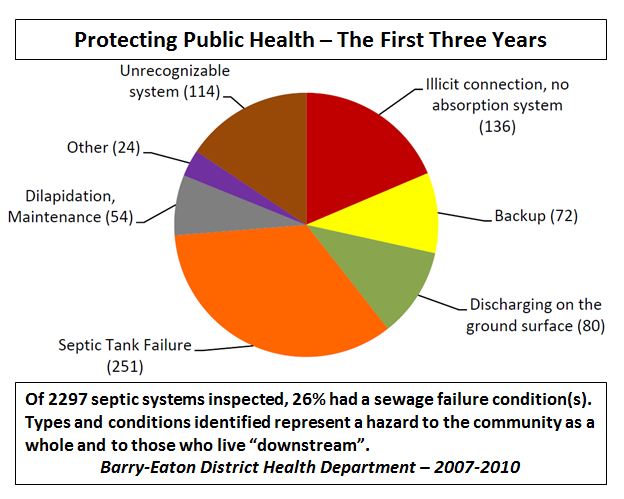Home>Our Work>Watershed Advocacy>Septic Systems
Septic Systems

When your septic system is correctly placed, adequately designed, carefully installed and properly managed, you will have a wastewater treatment and dispersal system that is simple, economical, effective, safe and long lasting. A failing system may result in property damage, odor surface and possibly groundwater contamination, disease potential and costly repairs or replacement.
Learn more about your septic system and how to properly maintain it?
Michigan State University Extension: Septic System Education
Do you have a problem? It's certainly not uncommon
In November of 2007, the Barry-Eaton District Health Department (BEDHD) implemented the time of sale or transfer program, commonly known as -TOST. The purpose of this program was to protect Public Health, the quality of water resources, and the environment. Was it effective? During the first three years of the program, 5013 well and/or septic systems were evaluated: 602 sites had sewage failure conditions (26%); 601 sites had well failure conditions (22%). Read the details here and see a photographic presentation here.
District Health Department (BEDHD) implemented the time of sale or transfer program, commonly known as -TOST. The purpose of this program was to protect Public Health, the quality of water resources, and the environment. Was it effective? During the first three years of the program, 5013 well and/or septic systems were evaluated: 602 sites had sewage failure conditions (26%); 601 sites had well failure conditions (22%). Read the details here and see a photographic presentation here.
More links...
Barry-Eaton TOST Regulation with Exception and Escrow forms.
EPA Homeowner's Guide to Septic Sysytems
Do you know if your drinking water is safe?
SWMPC - Septic System Care
NPR Environment report - Septic Systems (Audio file)
RV Dumping - Keep our waters pure when traveling.
Common Septic System Problems
By Murray Anderson*
A well-designed septic system dealing only with human biological waste quite likely wouldn't have any of the problems commonly associated with them. A septic system is essentially a large holding tank designed to hold human biological waste material until natural bacterial action breaks it down into three components - gases, water (mixed with some components that aren't consumed by bacterial action) and solids. Over time, the gases and water are eliminated from the tank into the immediate environments (the gas through vents and the liquids through tubes extending out into a distribution field), while the solids sink to the bottom and must be periodically removed from the tank by pumping.
However, biological processes do take time to turn the waste into water and gas and septic systems are commonly asked to handle much more than just human waste. In most homes, they have to deal with kitchen wastes, lots of water from family baths and showers plus the output from dishwashers and washing machines (including soaps and detergents), plastics and non-biodegradable ‘flushable' products and sometimes even things like solvents, paint thinners or even gasoline.
As a result, it's pretty easy to figure out what causes most common septic system problems - we're asking them to deal with things they aren't designed to handle.
- Excess water means the solid wastes don't get a chance to break down before the water level in the tank raises so high that solid matter passes out of the tank into distribution tubes that are only built to handle liquids, effectively blocking the tubes.
- Non-biodegradable products in the tank fill up space and will never go away naturally. Once again raising the liquid levels in the tank higher and forcing floating solids into the distribution system.
- Phosphates from detergents act as fertilizer encouraging algae growth that can block the perforations in the distribution pipes.
- Chemical products like solvents and paint thinners are toxic and by putting them into a septic system, they are distributed into the surrounding soil, polluting it and making it unfit for plant growth.
How to eliminate common septic system problems
- Minimize the amount of water going into your septic system by spreading out clothes washing over a number of days, rather than doing all the family laundry on one day.
- Shorten the length of showers and use ‘low flow' showerheads to help keep excess water out of the system. Low flow or dual flush toilets will also minimize water going into the system.
- Use liquid or gel soap in dishwashers and washing machines - gel soaps don't contain phosphates like powdered soaps.
- Keep kitchen wastes out the system. This means no oil or grease down the kitchen drain plus, a garburator shouldn't be connected to the system (kitchen wastes break down differently than human waste).
- Keep all non-biodegradable products out of the system. This includes flushable items like tampons, diapers, paper towels even cigarette butts.
- Never use your septic system as way to get rid of toxic materials like solvents and paint thinners. They won't be eliminated; they will simply be distributed into the soil.
- Commercial products that claim to clear septic systems often contain toxic or hazardous chemicals like lye that are bad for the environment.
- Finally, have your system pumped out on a regular basis (experts suggest every two to four years) to ensure the system has enough capacity to work efficiently.
*Murray Anderson is an experienced freelance writer with over 500 articles published on the web as well as in print magazines and newspapers in both the United States and Canada. He writes on a wide range of topics and is a regular contributor to DoItYourself.com. He can be contacted at murand@lycos.com.

